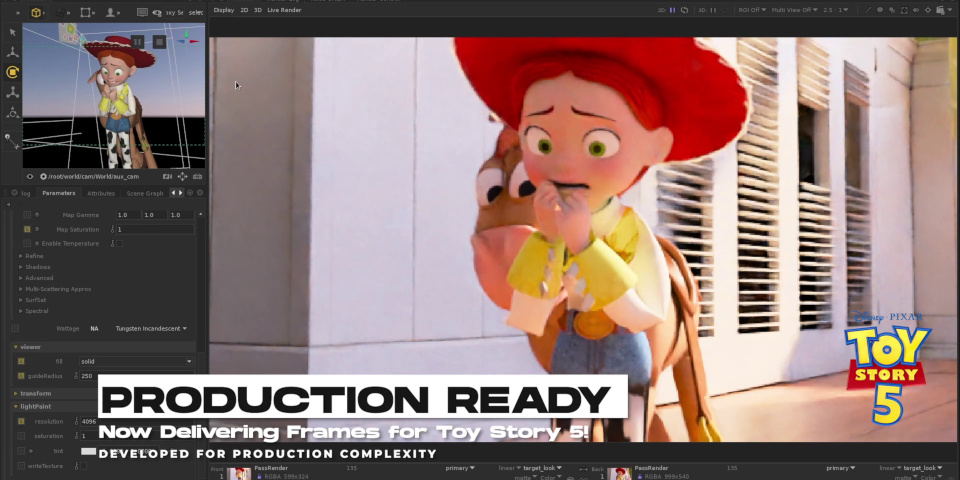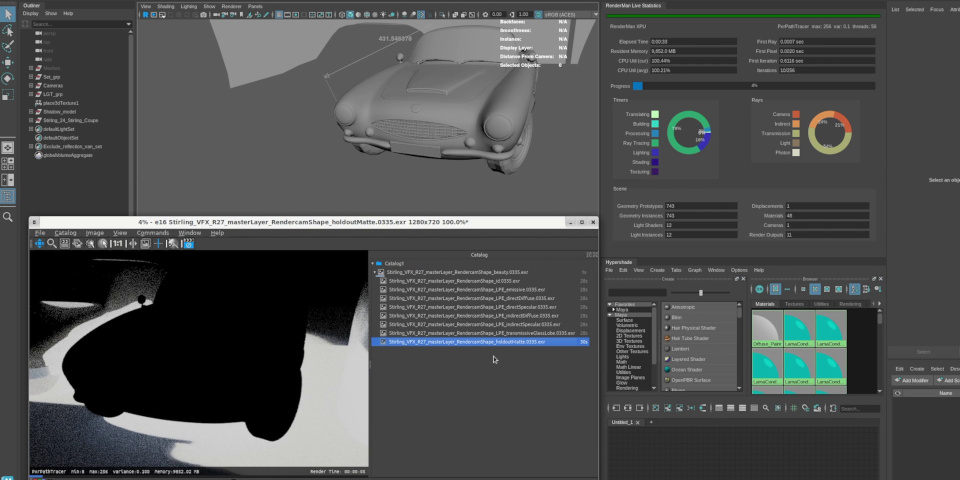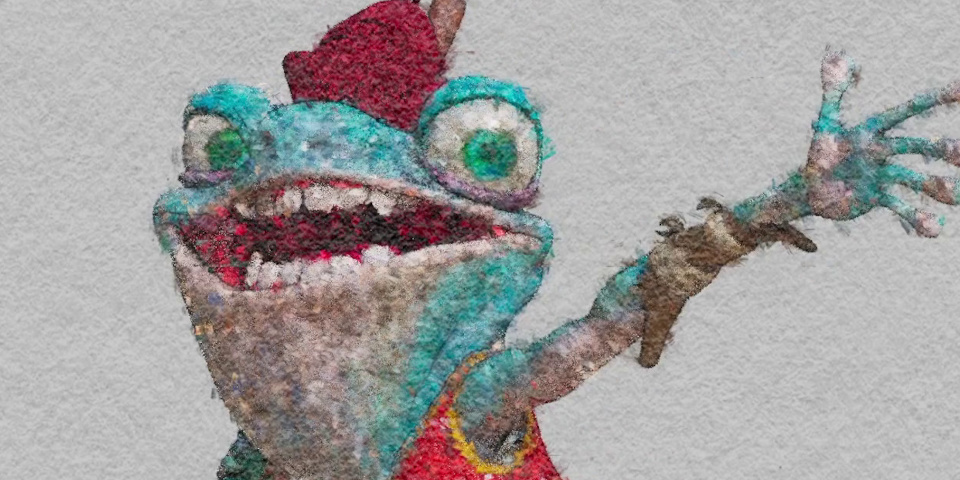Pixar releases RenderMan 27
Originally posted on 27 September 2025 for the beta, and updated for the final release.
Pixar has released RenderMan 27, “the most significant release in over a decade” for the heavyweight production renderer for VFX and animation.
The update makes RenderMan XPU, the software’s hybrid CPU/GPU render engine, ready for final-frame rendering as well as interactive previews.
Key changes in XPU include interactive denoising, deep workflows, support for mattes and holdouts for compositing, extended shading capabilities, and support for multi-GPU rendering.
The updated version of XPU is also available in the free non-commercial edition of RenderMan, and supported in the integration plugins for Blender, Houdini, Katana and Maya.

RenderMan XPU becomes officially ready for final-frame rendering
The main change in RenderMan 27 – and it’s a massive one – is that RenderMan XPU, the software’s hybrid CPU/GPU render engine, becomes officially ready for final-frame rendering.
Introduced in RenderMan 24 in 2021, and updated in subsequent releases, XPU provided a faster alternative to RIS, RenderMan’s CPU-only render architecture, for look development and interactive rendering, but lacked support for key features needed for final-frame workflows.
In RenderMan 27, the two move much closer to feature parity, with XPU supporting “nearly all key production features previously exclusive to RIS”.
Although RIS is still available in RenderMan 27, it is now due to be deprecated in a “future release”, and studios are encouraged to adopt XPU in production for new projects.
Pixar itself has put theory into practice, using XPU for final-frame rendering on the upcoming Toy Story 5.
In its online FAQs, which cover the transition from RIS to XPU, Pixar describes XPU as “2-10x faster [than RIS] in most cases”.

RenderMan XPU now supports holdouts for VFX compositing workflows.
XPU: better support for VFX compositing workflows
As a result, most of the changelog for RenderMan 27 consists of features that were previously only supported in RIS, but which are now also supported in XPU.
For visual effects work, some of the most significant will be the new compositing capabilities, which include support for mattes, holdouts, and deep output.
For deep compositing workflows, RenderMan XPU now has “full support” for OpenEXR Deep IDs, including the ability to automatically generate OpenEXR 3.0-style ID manifests.
The important Cryptomatte matte ID system isn’t supported in RenderMan 27.0, but Pixar plans to do so in a ‘dot release’ – that is, a RenderMan 27.x update.

RenderMan’s Stylized Looks toolset gets new Painterly effects, also supported in XPU.
XPU: support for the new AI denoiser and Stylized Looks
XPU also now supports two of the most significant features added to RenderMan in recent releases: the new interactive denoiser, and the Stylized Looks toolset.
Introduced in RenderMan 25, the AI-trained temporal denoiser reduces iteration times during look development, particularly on scenes with complex lighting or shading setups.
Stylized Looks, originally introduced in RenderMan 24, is a non-photorealistic rendering toolset, capable of a range of stylized output, including cartoon, sketch-like and painterly looks.
In RenderMan 27, it is “not only fully implemented in XPU, but is also greatly expanded”, with new features including support for Painterly looks as well as Lines, Hatching and Toon effects.

XPU: support for more shading and lighting features
For look development, XPU now supports a number of shading features previously only supported in RIS.
That includes full support for Open Shading Language (OSL) display filters, partial support for OSL sample filters, and support for “most” of the getattribute() lookups available to RIS.
And while it isn’t fully supported in XPU in RenderMan 27.0, MaterialX Lama, RenderMan’s layered material system, is in early access, with full support due in “the 27 release cycle”.
General MaterialX support in XPU is in “active development”, but seems to be further off.
Other changes include nested instancing with material inheritance; and improvements to subsurface scattering, single-surface scattering for glass and volumetrics, and hair rendering.
For lighting, XPU now fully supports mesh lights, and supports interior volume aggregates, for more accurate rendering of materials like crystals or murky liquids.
XPU: checkpointing and support for multi-GPU rendering
There are also some significant workflow improvements to XPU, including checkpointing.
XPU can now output partial frames as checkpoints from which it can resume interrupted renders, reducing time spent on re-rendering and improving production efficiency.
In addition, XPU now supports multiple GPUs in both hybrid and GPU-only modes, helping to maximize use of hardware resources when rendering on GPU farms.
However, it doesn’t ease the memory restrictions inherent in GPU rendering: all of the GPUs must be identical, and the scene being rendered must fit into the memory of each GPU.
Some limitations still remain when using XPU for final-frame rendering
And while XPU is now feature-complete enough for Pixar to recommend that studios begin moving to it for final-quality output, it still has some limitations in RenderMan 27.
One is scenes with very large numbers of lights: below several hundred lights, XPU converges faster than RIS, but above that, RIS begins to outperform it.
XPU also does not support light transport algorithms like bidirectional path tracing and photon mapping, so “very difficult” lighting scenarios like underwater caustics may also still require RIS.
Second, XPU does not support baking workflows, although baking in RIS and using the baked results in XPU “may be a viable alternative”.
Third, XPU still does not render some types of geometry, particularly NURBS and quadrics, although that’s unlikely to be a major issue for entertainment work.
In addition, XPU currently requires a NVIDIA GPU, so it’s available on Windows and Linux only.
Pixar plans to support Macs with Apple Silicon processors – all Macs released after 2023 – in a 27.x release, but only for RIS: Apple Silicon support for XPU will follow in a “future release”.
Pipeline integration: support for VFX Reference Platform 2024 and updated bridge plugins
RenderMan 27 will also bring the software closer to the current VFX Reference Platform standard, although it supports last year’s CY2024 spec, not CY2025.
For pipeline integration, all of the bridge plugins for DCC software – Blender, Houdini, Katana and Maya – have been updated to support the new features in RenderMan 27.
The Texture Manager in the bridge plugins now defaults to OpenImageIO for mipmapped texture conversion, reducing processing times, and replacing Pixar’s .tx format with the more standard OpenEXR.
Blender users also get support for Blender’s native light linking workflow, and a number of workflow improvements, including a UI button to stop and restart IPR renders.
Houdini users get extended support for the Solaris look development and layout toolset.
Price and system requirements
RenderMan 27.0 is compatible with Windows 10+, macOS 15.x+ and glibc 2.34+ Linux (equivalent to RHEL 9+). The plugins are available for Blender 3.6+, Houdini 20+, Katana 7+ and Maya 2024+.
RenderMan XPU is supported on Windows and Linux. It requires a NVIDIA Pascal GPU or newer.
New perpetual and node-locked floating licenses cost $845, including 12 months’ maintenance. There is also a free non-commercial edition.
Read an overview of the new features in RenderMan on the product website
Read a full list of new features in the RenderMan 27.0 in the online release notes
Read Pixar’s online FAQs about RenderMan 27 (Covers transitioning from RIS to XPU)
Have your say on this story by following CG Channel on Facebook, Instagram and X (formerly Twitter). As well as being able to comment on stories, followers of our social media accounts can see videos we don’t post on the site itself, including making-ofs for the latest VFX movies, animations, games cinematics and motion graphics projects.
Homepage image: A still from upcoming Pixar animated feature Hoppers, currently being used as the header image for the ‘What’s New’ page on the RenderMan product website.
